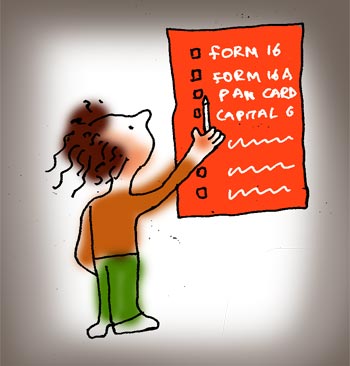 | « Back to article | Print this article |
Tax: 14 must-knows of Form 16
By now most salaried employees must have received their Form 16 from their employers. Now it's time to file the return. Though we know that Form 16 is for tax filing but many of us still find it hard to understand the components of Form 16 while filing the return. Understanding Form 16 is the key to a better tax planning.
What is Form 16?
It is certificate issued by the employer to employee stating the details of income earned and the tax deducted on your behalf and paid to the government. Every employee who is subjected to TDS is supposed to receive their Form 16 by April 30 every year. However many employers issue it post this deadline.
Click NEXT to read more
Tax: 14 must-knows of Form 16
Points to be remembered:
- No Form 16 is required if TDS is not deducted from salary
- If TDS is deducted by banks to the pension holder, banks should also issue Form 16. For interest income the bank issues form 16A
Components of Form 16
1. PAN
PAN stands for Permanent Account Number which is a 10 digit alpha-numeric code generated by the Income Tax Department of India.The tax department has made it mandatory for everyone (including NRIs, PIOs & Companies) who wishes to conduct any type of investments and financial transactions in India.
Carrying business, filing or paying taxes, investing in India, buying a property, opening a bank or demat account, etc. now require a PAN number.
Click NEXT to read more
Tax: 14 must-knows of Form 16
2. TAN
TAN or Tax Deduction and Collection Account Number is a 10 digit alpha-numeric number required to be obtained by all persons/companies who are responsible for deducting or collecting tax. TAN numbers are also unique to companies.
3. Gross salary
It refers to total of an employee's regular remuneration including allowances, overtime pay, commissions, and bonuses, and any other amounts before any deductions are made.
4. Perquisites
Perquisite is an additional benefit provided by the employer to the employee in addition to the salary or wages. It is also called perks in short.
For example, rent free accommodation, loans at a subsidised rates to employees etc.
5. Profits in lieu of salary
Profit in lieu of salary is a part of the salary income. Thus it is taxable under the head income from salary. It is any payment made to employees in lieu of salary. Which means any payment due to or received by employee from his employer or former employer at or in connection with the termination of employment or due to modification in terms and conditions relating thereto.
For example, gratuity, commuted value of pension, retrenchment compensation etc. received or due to be received to the extent which is not exempt, and which it does not consist of contribution made by the employee, or interest thereon will be taxable as profit in lieu of salary.
Click NEXT to read more
Tax: 14 must-knows of Form 16
6. Allowance
Allowance is a payment made by employer to an employee to enable the employee to meet certain cost of expenditure incurred on behalf of the employer. This generally forms the part of the employee's taxable income.
Example: Medical allowance, travel a etc.
The following are most important allowance which we will come across in most Form 16s.
7. House rent allowance
HRA is a special allowance given to an employee to meet her/his rent expenses. It is exempt from tax to the extent of least of the following:
- HRA received from employer
- Rent paid in excess of 10% of the salary
- 40% or 50% of the salary (50 % in case of an individual belongs to metropolitan cities like Mumbai, Delhi, Chennai, Kolkata for all others it is 40%)
Note:
- Salary for HRA calculations: Basic + DA + Commission (Paid as a fixed percentage of sales)
- Above exemption is only available on actual payment of rent
For example, let us understand this with an example. Say, you live in Hyderabad and your salary structure for a month is as follows:
- Basic: Rs 12,000
- HRA: Rs 5,000
- Other taxable allowances: Rs 2,000
- Monthly rental expenses Rs 7,000
Now, HRA will be exempt to the extent of the least of:
- Rs 4,800 (40% of salary for non-metro); or
- Rs 5,000 (HRA received); or
- Rs 5,800 (excess of rent paid over 10 per cent of salary, i.e. (7000-(10% of 12,000)
- HRA exemption will be the least of the above, that is, Rs 4,800
Click NEXT to read more
Tax: 14 must-knows of Form 16
8. Conveyance allowance
It is an allowance granted to the employee by her/his employer to meet the expenses incurred on commuting from home to the place of her/his residence. Conveyance allowance is exempt to the extent of Rs 800. An orthopedically handicapped employee enjoys a higher exemption of Rs 1,600
9. Medical allowance
Medical allowance is an allowance paid to the employee to cater the amount spends by employee on medical treatment and medicines. Medical allowance can be paid out monthly or yearly. Medical allowance is a fully taxable component of the salary.
However, if you receive reimbursement of medical expenses against submission of bills, such reimbursement is tax free up to Rs 15,000 per year
10. Entertainment allowance
It is the amount paid by employer for availing entertainment services. Deduction on entertainment allowance is only is allowed to government employees. The amount of deduction allowed is to the extent of least of the following:
- Actual allowance received
- 1/5th or 20% of the salary (excluding all other allowances benefit or any other perquisites)
- Rs 5,000
Click NEXT to read more
Tax: 14 must-knows of Form 16
11. Deductions
Government encourages certain type of savings -- mostly long term savings for your retirement -- and therefore offers you tax breaks on such savings. These tax breaks are nothing but deductions allowed from the gross total income (Chapter VI A).
12. Surcharge
Surcharge has been abolished for personal income tax in the financial year 2009-10.
13. Education cess
Education cess is a contribution made towards the Secondary and Higher Education development in the economy. All taxes in India are subject to an education cess, which is 3% of the total tax payable.
14. Relief u/s 89
Relief is granted to individuals when salary is paid in arrears in a lump sum.
For example, salary (received in arrears/advance, family pension received in arrears, retirement benefits such as gratuity, commuted pension, VRS and retrenchment compensation)





